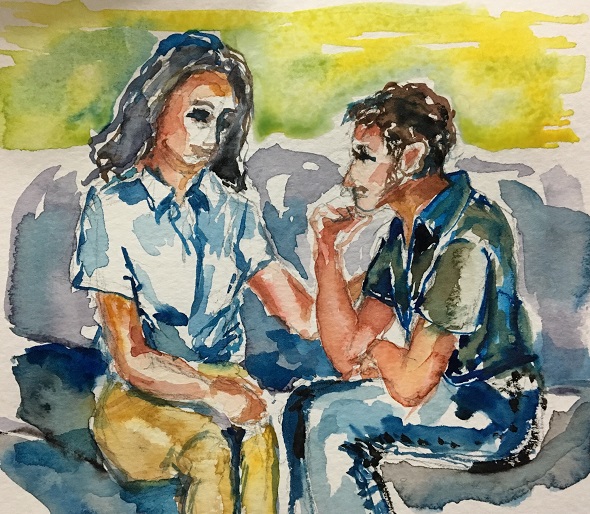Learn.
Learn what constitutes an evidence-informed treatment plan for the medical condition of substance use disorder, popularly termed “addiction.” Acknowledge that debate rages, even among experts and researchers, about what addiction is and what effectively treats it. Discourse is, of course, necessary, but your loved one needs help now. Learn what the evidence suggests helps most people with substance use disorder, most of the time, better than other treatments, and better than no treatment.
Read Unbroken Brain: A Revolutionary New Way of Understanding Addiction, by Maia Szalavitz. If you only have time for two chapters, read Chapters 11 and 12.
Understand.
Learn enough about addiction to understand what people with the disorder experience, why their actions may not make sense, why abstinence is neither a cure nor a relief, and why they might not want treatment. Understand that substance use disorder occurs with multidimensional complexity and variability. Use terms related to addiction accurately and humanely.
In particular, understand that the neuroscience of addiction suggests that through compromising the brain’s basal ganglia, extended amygdala, and prefrontal cortex, addiction under-sensitizes people to pleasure, over-sensitizes them to pain, automates use of the substance to feel, not necessarily good, but normal, weakens decision-making abilities, magnifies emotional highs and lows and incapacitates the ability to regulate them, interferes with recognizing cause-and-effect relationships, and confounds the ability to make a plan and follow through with it.
“Do not attempt to take away a person’s main means of trying to cope with pain and suffering until you have another effective coping strategy in place.”
– Alan Marlatt, Ph.D., 2004
Many people have misinformed beliefs about addiction. Even people with substance use disorder may not fully understand the condition. Misbegotten beliefs can endanger people. Challenge your beliefs through your studies. Try not to say anything about addiction or its treatment for which you can’t cite research.
Encompass.
Be brave. Beyond the medical condition of addiction which compels use, become aware of, seek, and acknowledge all the possible current conditions, risk factors, and pre-existing conditions – including trauma and mental illness – that might lead your loved one to find use of substances appealing, helpful, or meaningful. If the person initiates the discussion, without judgment, be open to talking about these with your loved one. Approaching difficult subjects, rather than avoiding them, can be painful, difficult work. Get support for yourself so you can support your loved one.
What substances do for a person – including helping with past pain, current distress, and anxious worry about the future – will need to be adequately replaced before a person can do without them. Expand and deepen your already-present empathy and compassion for these conditions and reasons, and for the person who has them.
Love.
Offer love love, not tough love.
Co-create.
If your loved one is in an emergency state, dial 911 or get him or her to an ER.
If not, your loved one may be newly released from the hospital, newly released from treatment, or in need of urgent care.
Having grounded yourself in learning, understanding, compassion, and love, confer with your loved one about what next steps might be helpful. Although the situation might seem dire, co-decide on the smallest step that might make a slight improvement – perhaps finding an answer to a question through a phone call or a Google search – and do that. Don’t try to strategically build trust – be trustworthy.
This is subtle, but the goal of helping someone with substance use disorder isn’t to take over the person. The goal is to help the person be himself or herself and move towards health, in the increments that work for him or her. Going slowly enough has to be balanced with going quickly enough to outrun the defining characteristic of addiction, “persistence despite adverse consequences.”
Use the best of your heart, mind, knowledge, experience, wisdom, and presence, all together, all at once. The substance is perceived as needed to survive. The illness of addiction, the symptoms of co-occurring illnesses, and the impact of substances themselves can interfere with a person’s reasoning. Assume the person is often in a state of alarm. Arguing with you, wanting to leave, sitting on the couch while the dishes remain undone – that may be the fight-flight-freeze response.
You will be tempted to make suggestions and offer advice. At the fundamental level, however well-meant, unsolicited advice comes from the advice-giver’s own fear and doubt. The receiver may even agree with the suggestion, but hears the uncertainty from a person they revere. This confirms one of their own deepest fears: “If they don’t think I can do this, maybe I can’t…” Counterintuitively, giving advice to hasten progress actually thwarts it. Talk to a counselor or a friend about your very legitimate fear, but not with your loved one. To your loved one, convey your hope and confidence.
Co-creating solutions with a person under such duress will take the very best of your full humanity.
Budget.
The primary reason rehabs exist – especially locked facilities – is fear. We’re afraid our person’s experience of the defining trait of addiction – persistence despite adverse consequences – will kill them. Return to use rates after rehab are 70% or higher. Coordinating local treatment may be a more effective option. However, health professionals are reluctant to take substance use disorder cases because health insurance reimbursement rates can range from 0% to 20%. Assume you will have to pay full fees, out-of-pocket for local treatment.
People with illnesses need daily treatment and care. Find the going rate for daily, individual counseling sessions offering evidence-based protocols. Find the going rate for daily 24-7 companion care. Do the numbers. Figure out how much you can pay and/or are willing to pay. Figure out how much volunteer care you can coordinate on your own, perhaps using Doodle for scheduling.
The primary feelings people have about needing treatment are guilt and shame, especially over expenses. You can ease your loved one’s distress and foster his or her autonomy by sharing exactly what funds are available and for how long. “Whatever it takes” may be our wish, but it usually isn’t possible.
Coordinate.
Serve as your loved one’s case manager and do what you can to make the components of the treatment plan happen, starting with medical care. Make inquiries and appointments, make phone calls and follow-up phone calls, make copies of all documents, keep originals in a safe place, create a notebook of the copies, provide or find transportation, and accompany your loved one to as many appointments as possible, notebook of copies in hand.
Advocate.
Your loved one has a medical condition needing medical care, but society at large believes it is a moral and criminal problem needing redemption and punishment. Even your loved one may believe he or she is a good person gone bad. Your natural inclination may be to walk away from care providers who hold these views. Since it’s a position held by the majority, doing so may leave you with no alternatives and no care. Instead, you may need to learn to skillfully and strategically advocate to procure the necessary treatment component from each individual or entity.
Insist on outcome-based treatment. If the treatment providers don’t have data that the treatment works – data that counts all the people who started the treatment, not just the people who finished – ask them for the criteria used to decide which treatment protocols are offered. If a treatment isn’t known or proven to work, why would your loved one be required to do it? People mandated to treatment may have to attempt to make the best of what’s offered. You can convey, however, that you will be overseeing your loved one’s progress.
Acknowledge.
Acknowledge the on-going alarm and distress 1) of having a loved one with an illness that leads them to say and do things that hurt a person you love – themselves – and you, 2) of living under the constant threat of the defining symptom of addiction – “persistence despite adverse consequences.”
Consider asking a physician for a referral for a trauma assessment. If you have symptoms of Post-Traumatic Stress Disorder (PTSD), seek evidence-based treatment from a qualified health care professional.
“Each one of us here today will at one time in our lives look upon a loved one who is in need and ask the same question: We are willing to help, Lord, but what, if anything, is needed? For it is true we can seldom help those closest to us. Either we don’t know what part of ourselves to give or, more often than not, the part we have to give is not wanted. And so it is those we live with and should know who elude us. But we can still love them – we can love completely without complete understanding.”
– Norman Maclean, A River Runs Through it and Other Stories
Commune.
Find others with loved ones with substance use disorders and connect with them in ways that are supportive, informative, and empowering. Community Reinforcement and Family Training (CRAFT) is an evidence-backed approach, developed first for alcoholism, and known since the 90s to foster engagement between people with substance use disorders and those who love them towards achieving treatment goals. Even if implementation of a CRAFT program is not possible in your area, finding others who value a CRAFT goal – “Minimize distress and increase positive lifestyles for all family members” – may be encouraging and strengthening.
- More about CRAFT
- CRAFT video series
- CRAFT manual – .pdf opens in new tab.)
“Love, evidence & respect.”
– Maia Szalavitz’s answer via Twitter to the question, “What fights addiction?”
Further reading
Recommended reading
- Unbroken Brain: A Revolutionary New Way of Understanding Addiction, Maia Szalavitz, 2016
- Facing Addiction in America: The Surgeon General’s Report on Alcohol, Drugs and Health, November, 2016
- The Wrong Way to Treat Opioid Addiction, Maia Szalavitz, New York Times, 1/17/18
- Additional resources
Watercolor by Jesi Pace-Berkeley
Lawson Koeppel contributed to this post.
Last updated 6/22/19
The views expressed are mine alone and do not necessarily reflect the positions of my colleagues, clients, family members, or friends. This content is for informational purposes only and is not a substitute for medical or professional advice. Consult a qualified health care professional for personalized medical and professional advice.

